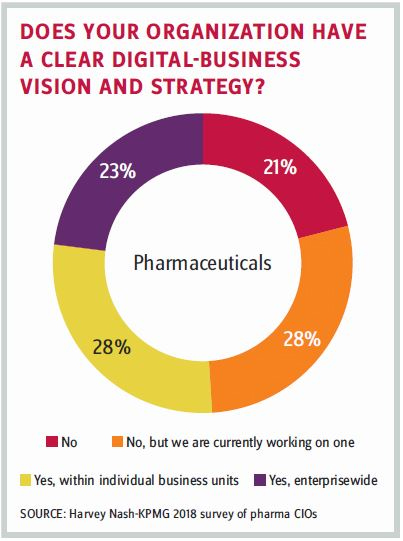Blockchain's Evolving Role In The Life Sciences Supply Chain
By Arun Ghosh, KPMG

In the Harvey Nash-KPMG 2018 survey of pharma CIOs, artificial intelligence was the leading technology, with 28 percent saying they made moderate to significant investments in the technology. Blockchain was tied with augmented/virtual reality, with 6 percent of CIOs saying it received a moderate/significant investment.
While blockchain has generated buzz from the volatility of cryptocurrencies as investments, the CIOs may be overlooking the technology’s potential to transform how pharmaceutical companies operate.
As it stands now, the sector is in the pilot stage, with many initiatives underway. The primary business case for blockchain in the pharmaceutical industry is its ability to serve as a “ledger of truth” when complex information needs to be shared with business partners across the supply chain, including those unique to life sciences, such as regulators, pharmacy benefit managers, and contract manufacturers.
These are some of the events shaping the use of blockchain in life sciences through 2019:
- A major pharmaceutical maker teamed up with a wholesaler to implement the technology to manage returned products. One of the truisms of the supply chain is that each transaction opens a new opportunity for distribution to be compromised. The pilot is to comply with the Drug Supply Chain Security Act (DSCSA), since part of the law requires traceability, even for medications that have to be destroyed for being outdated, withdrawn, or recalled.
- Patient communications pertaining to adherence, financial support, and copay cards require a great deal of information to be exchanged and add a great deal of overhead to the healthcare system. Blockchain can make this record keeping much more seamless and can allow information to flow where it is needed while adhering to regulations. With many drugs gaining more approvals with REMS (risk evaluation and mitigation strategies), postmarketing data collection can be conducted via blockchain.
- Synaptic Health Alliance, a group of leading healthcare payers, providers, and a lab services leader, is conducting a pilot to maintain physician directories, a data-intensive and time-consuming task. With companies of this scope involved with blockchain, entities seeking to establish a “trust network” are building momentum to establish clinical-data-technology standards, including those for EHRs. As many industry observers know, interoperability among EHR vendors has been a consistent complaint from healthcare providers. Blockchain can be a foundational part of addressing this complaint across the continuum of care.
In effect, the technology can simplify and automate tasks to keep the parties connected with necessary information in a secure format.
Blockchain also can have a role in contract manufacturing, particularly in the technology transfer to a contract manufacturer in Phase 2 studies. Many biotech organizations lack the ability to manufacture products at scale, so intellectual property management and licensing agreements need to be verified and maintained. Blockchain can help keep the originator of the product and the contract manufacturer aligned over their respective roles and serve as immutable proof about where the product is in the supply chain.
Storing data on a blockchain can help with language and regulatory barriers in an increasingly global drug development environment and can aid in the transmission of data from study sites to the manufacturer and, eventually, regulators.

SECURITY, INTEROPERABILITY KEY TO SUPPLY CHAIN INTEGRITY
As supply chains become more complicated, with outsourced manufacturing and diverse streams of raw materials leading to medicines that are more valuable in weight than gold, blockchain lends a degree of interoperability and security to track and trace materials efficiently. Contract managers can simplify and automate complex tasks from manufacturers to wholesalers, to pharmacies, and finally to the patient, while payers can have a role in prior authorization and claims management in this process. The technology can increase transparency among payers, providers, drugmakers, pharmacies, and patients.
Security is among the most significant features of blockchain technology, since all parties can see how and where data changed in the ledger. This pertains not only to privacy regulations, such as HIPAA or GDPR, but also to rules aimed at the integrity of the supply chain. The technology can help drugmakers address the requirements of the Drug Supply Chain Security Act (DSCSA), which requires pharmaceutical companies to track and trace medications throughout the supply chain to prevent diversion, counterfeiting, and tampering.
When using a blockchain, drugs are logged as digital assets during the serialization process at the manufacturing plant. These goods are then tracked throughout the supply chain as they progress from manufacturers, to distributors, to retailers, and, ultimately, to patients. Evolving product information and locations are logged onto the blockchain and accessed by authorized parties through a dashboard. In the event of a product recall, all affected products can be traced back to the manufacturer and relevant parties can be alerted.
Blockchain’s security capabilities also come into play through this dashboard. Any attempts to tamper with the “record of truth” are revealed to all parties simultaneously, making fraudulent activity more difficult and leaving a record for regulators, auditors, and compliance officials to follow.
DON’T BELIEVE THE HYPE
Enterprise blockchain offers a serendipitous opportunity to resolve regulatory and technological issues for pharmaceutical makers that is both affordable and less complex than what all the hype makes it out to be. The supply chain and business processes are extremely data- intensive. Technology does a great job of processing massive amounts of data, keeping track of it, and allowing it to be sifted and analyzed. Blockchain allows for easier data gathering and reporting to the FDA, and tracking products from manufacture to dispensing.
Quietly, businesses are using blockchain for more fundamental tasks tied to tracking assets, keeping records, and serving as a ledger of truth to connect businesses. Pharmaceutical makers are concerned about the “last mile” of how their products reach their patients, especially with drugs that can cost tens of thousands of dollars annually. Payers are increasingly looking to tie value and outcomes to how they reimburse drugmakers, so drugmakers have a vested interest in making sure the medications are used properly. Companies may even develop “after-the-pill” services to help with medication adherence, managing side effects, or taking other steps to improve clinical outcomes.
Blockchain’s record-storing capabilities can aid these services across the continuum of care, which can make technology arrangements among payers, providers, and life sciences companies much more important. While AI seems to be getting the investment dollars, according to CIOs, blockchain — with its ledgers of truth — can be a foundational part of an IT program in the life sciences. Ultimately, the industry needs to look to joint application of AI, blockchain, and other technologies tied to digital transformation to improve patient care.
ARUN GHOSH is U.S. blockchain leader at KPMG U.S. where he leads KPMG’s consulting services for blockchain across industries, from strategy to implementation.
